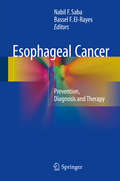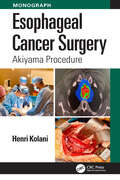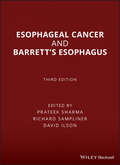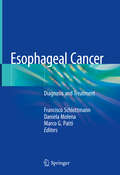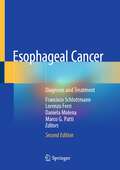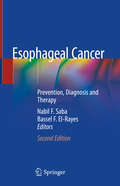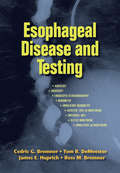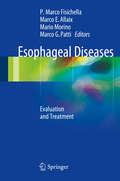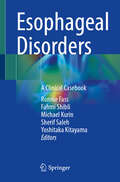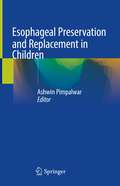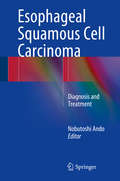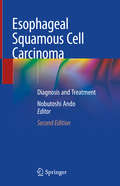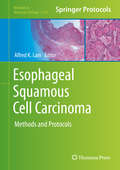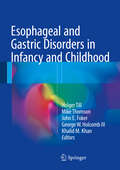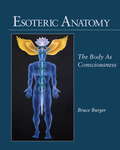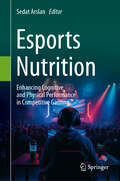- Table View
- List View
Esophageal Cancer
by Nabil F. Saba Bassel F. El-RayesThis book reviews the recent progress made in the prevention, diagnosis, and treatment of esophageal cancer. Epidemiology, molecular biology, pathology, staging, and prognosis are first discussed. The radiologic assessment of esophageal cancer and the role of endoscopy in diagnosis, staging, and management are then described. The principles of surgical resection, radiation therapy, and systemic chemotherapy for esophageal cancer are explained, and particular attention is paid to the multidisciplinary management of early-stage cervical, thoracic, distal, and junctional tumors. Up-to-date information is also provided on the treatment of metastatic and recurrent disease and on approaches that may affect future care, such as chemoprevention. Esophageal cancer remains one of the least studied cancers although it accounts for more than 400,000 deaths across the globe each year. The majority of esophageal cancers worldwide are squamous cell carcinomas, yet in the past few decades major epidemiologic changes have occurred affecting the incidence of adenocarcinomas in Western countries. Despite the advances in surgical and non-surgical therapies, overall survival has not changed significantly. It is hoped that Esophageal Cancer: Prevention, Diagnosis and Therapy will assist specialists from a variety of disciplines, including surgery, radiation therapy, gastroenterology, and medical oncology, in delivering optimal, up-to-date care to the benefit of patients.
Esophageal Cancer Surgery: Akiyama Procedure
by Henri KolaniA specialist clinical monograph for thoracic and general surgeons who specialize in the treatment of esophageal cancer, supported by practical images and video.Esophageal cancer is a challenging area which includes the specialties of gastro-hepatology, radiology, radio-chemotherapy, anesthesia, psychology and surgery, requiring treatment by a multidisciplinary team. In this type of surgery tumors located in the middle and upper 1/3 present a particular challenge, so the author describes how the use of the Akiyama procedure can alleviate this, maximizing operative access.This content is suitable for practicing surgeons with a range of surgical experience, and the step-by-step approach is fully illustrated with both photographs and access to operative videos. Key points are described, and potential pitfalls explained.
Esophageal Cancer and Barrett's Esophagus
by David Ilson Richard Sampliner Prateek SharmaEsophageal Cancer and Barrett's Esophagus 3E will focus on these two common and key conditions that affect the esophagus, providing expert guidance to their pathogenesis, cause, prevention, diagnosis and clinical management. Top international names in the field will examine each of the many issues involved using the very latest evidence-based research, and clear, didactic advice will allow the reader to understand the best methods of diagnosis and clinical management of each condition - whether early or late stage. Well-illustrated and fully revised to include the latest in ACG/ASG/UEGW guidelines, it will be the perfect consultation tool for gastroenterologists and oncologists managing patients with cancer of the esophagus. It will also be ideal for teaching residents and fellows optimum patient management, and for identifying areas requiring future research.
Esophageal Cancer: Diagnosis and Treatment
by Marco G. Patti Francisco Schlottmann Daniela MolenaThis book provides comprehensive and practical guidance for the management of esophageal cancer. It presents a detailed review of the pathophysiology, clinical staging, treatment, and outcomes of patients with esophageal cancer. Chapters cover the epidemiology of the disease, latest diagnostic and staging tools, systemic therapies, and the current open and minimally invasive surgical techniques including transhiatal, Ivor Lewis and McKeown esophagectomy. Esophageal Cancer: Diagnosis and Treatment compiles experience gained across a variety of medical disciplines, with contributions from world renowned surgeons, gastroenterologists, and medical oncologists. Thanks to its multidisciplinary authorship, this book represents a unique resource for anybody who takes care of patients with esophageal cancer.
Esophageal Cancer: Diagnosis and Treatment
by Marco G. Patti Lorenzo Ferri Francisco Schlottmann Daniela MolenaThis book provides comprehensive and practical guidance for the management of esophageal cancer. It presents a detailed review of the pathophysiology, clinical staging, treatment, and outcomes of patients with esophageal cancer. Chapters cover the epidemiology of the disease, latest diagnostic and staging tools, systemic therapies, and the current open and minimally invasive surgical techniques including transhiatal, Ivor Lewis and McKeown esophagectomy. Esophageal Cancer: Diagnosis and Treatment compiles experience gained across a variety of medical disciplines, with contributions from world renowned surgeons, gastroenterologists, and medical oncologists. Thanks to its multidisciplinary authorship, this book represents a unique resource for anybody who takes care of patients with esophageal cancer.
Esophageal Cancer: Prevention, Diagnosis and Therapy
by Nabil F. Saba Bassel F. El-RayesThe second edition of this very successful book documents the latest progress in the prevention, diagnosis and treatment of esophageal cancer and includes additional sections covering novel targeted therapeutic approaches, immunotherapy and palliative and nutritional support for patients. Furthermore, the sections covering epidemiology, molecular biology, pathology, staging and radiologic and endoscopic assessments have been thoroughly updated and expanded. The principles of surgical resection, radiation therapy and systemic therapy are reviewed and attention is paid to the multidisciplinary approaches to the management of early stage cervical, thoracic, distal and junctional tumors. Updated information is also provided on the treatment of metastatic and recurrent disease as well as approaches that may impact future care, such as chemoprevention. Esophageal Cancer: Prevention, Diagnosis and Therapy will assist specialists from various disciplines, including surgery, radiation therapy, gastroenterology, medical oncology and palliative medicine, in delivering optimal, up-to-date care to the benefit of patients.
Esophageal Disease and Testing
by Cedric G. Bremner Tom R. DeMeester James E. Huprich Ross M. BremnerA detailed compilation of the latest research and recommendations for the diagnosis and assessment of esophageal disorders, this reference delves into a wide range of applications and technologies currently utilized in the field including radiology, endoscopy, endoscopic ultrasonography, manometry, ambulatory manometry, pH testing, catheter-free pH
Esophageal Diseases
by P. Marco Fisichella Marco G. Patti Marco E. Allaix Mario MorinoThis project will cover the diagnosis and treatment of esophageal diseases in a concise and easy-to-read format. Pathophysiology, diagnostic evaluation, treatment and strategies for avoiding and managing complications are included and based both on evidence-based data and the experience of the Editors and the roster of international contributors. Each chapter will describe the current diagnostic and management strategies of the disease process and simplified operative approaches with relevant technical considerations will be outlined in an easily understandable manner for the specific target audience. The text will be illustrated throughout by easy to understand illustration line graphs that depict fundamental anatomic or technical principles.
Esophageal Disorders: A Clinical Casebook
by Ronnie Fass Fahmi Shibli Michael Kurin Sherif Saleh Yoshitaka KitayamaThis clinical casebook provides a comprehensive yet concise state-of-the art review of esophageal disorders. Presented in an easy-to-read, case-based format, each case focuses on a clinical scenario commonly encountered in practice, including history, diagnostic tests and detailed discussion, enhanced by many endoscopic photos, x-rays, CT scans, ultrasound and motility tests. More than 30 case scenarios include the evaluation, diagnosis and management of achalasia, diffuse esophageal spasm, ineffective esophageal motility, esophagogastric junction outflow obstruction, absent contractility, gastroesophageal reflux disease, eosinophilic esophagitis and others. Utilizing highly illustrative case material, Esophageal Disorders: A Clinical Casebook is a valuable resource for practicing gastroenterologsts, surgeons, primary care physicians, trainees (fellows and residents), medical students and other health care personnel.
Esophageal Preservation and Replacement in Children
by Ashwin PimpalwarThis book provides a comprehensive, state-of-the art, evidence-based review of esophageal preservation and replacement and serves as a valuable resource for clinicians, surgeons and researchers with an interest in this field. The text reviews in detail the embryology, anatomy and physiology of the esophagus relevant to esophageal replacement. The indications, advantages, disadvantages, complications and long-term outcomes of all techniques available are also discussed. The latest advances in this field including the laparoscopic and thoracoscopic techniques are included with detailed descriptions and figures. Recent advances in tissue engineering techniques for manufacturing a neo esophagus are also discussed in detail. All chapters are written by experts in their fields and includes the most up to date evidence-based data available.Esophageal Preservation and Replacement in Children is one of its kind and serves as a very useful resource for surgeons and researchers all over the world. It provides a comprehensive summary of the current status of esophageal preservation and replacement and all the recent advances in this field.
Esophageal Squamous Cell Carcinoma
by Nobutoshi AndoEsophageal cancer causes an estimated 386,000 deaths worldwide and is the sixth most common cause of death for men. The background characteristics of esophageal cancer treatment are markedly different between Asian and Western countries, however. In tumor histology, squamous cell carcinoma associated with smoking and alcohol consumption is overwhelmingly prevalent in Asia, whereas adenocarcinoma associated with Barrett's metaplasia is markedly prevalent in the West. In Asia, especially in Japan, the key persons who play important roles in the management of esophageal cancer patients are surgeons; in the West those roles are filled by medical and radiation oncologists as well as surgeons. The philosophy of surgeons regarding cancer surgery varies from locoregional to local tumor control, particularly in focusing on lymph node dissection. Physicians' approach to surgical adjuvant therapy differs, therefore, between Asia and the West. Considering these East-West differences in esophageal cancer treatment, the currently available results of Western evidence should not be considered directly applicable to esophageal cancer in Asia In this book, the authors discuss the knowledge base in Japan in terms of treatment of esophageal squamous cell carcinoma. Since this volume contains a wide spectrum of current information and addresses topics surrounding the treatment of patients with esophageal squamous cell carcinoma, it is highly relevant to Asian physicians and researchers as well as to their counterparts in the West.
Esophageal Squamous Cell Carcinoma: Diagnosis and Treatment
by Nobutoshi AndoThis is the second edition of the book, covering a wide spectrum of the latest information relevant to diagnosis and treatment of esophageal squamous cell carcinoma (ESCC). In recent years the incidence rate of esophageal cancer has been increasing; however, the background characteristics of the cancer treatment are significantly different between Asian and Western countries. In tumor histology, ESCC associated with smoking and alcohol consumption is overwhelmingly prevalent in Asia, whereas adenocarcinoma associated with Barrett’s metaplasia is remarkably prevalent in the West. In Asia, especially in Japan, surgeons play a significant role in the management of esophageal cancer patients, while medical and radiation oncologists as well as surgeons are important in the West. Considering these East–West differences in management of esophageal cancer, evidence originating in Asia should be more widely disseminated globally. The contributing authors, who have great expertise in their areas of specialization, discuss details in terms of treatment of ESCC, including basic science, diagnosis, surgery, other treatment modalities, Japanese guidelines, and also valuable experiences from other Asian countries. Accordingly, this excellent collection of texts benefits not only oncologists, but all medical and biological researchers involved in the latest ESCC research.
Esophageal Squamous Cell Carcinoma: Methods and Protocols (Methods in Molecular Biology #2129)
by Alfred K. LamThis volume provides current management and research protocols on oesophageal squamous cell carcinoma. Chapters guide readers through methods on clinical and pathological diagnostics, translational research for oesophageal squamous cell carcinoma, in vitro assays, liquid biopsy for cancer DNA and circulating tumour cells, genomic analysis, mi-RNAs, and proteins. Written in the highly successful Methods in Molecular Biology series format, chapters include introductions to their respective topics, lists of the necessary materials and reagents, step-by-step, readily reproducible laboratory protocols, and tips on troubleshooting and avoiding known pitfalls. Authoritative and cutting-edge, Esophageal Squamous Cell Carcinoma: Methods and Protocols to ensure successful results in the further study of this vital field.
Esophageal and Gastric Disorders in Infancy and Childhood
by Mike Thomson Holger Till John E. Foker George W. Holcomb III Khalid M. KhanEsophageal anomalies and disorders in infancy and childhood include a wide spectrum of different diseases. These range from emergencies immediately after birth such as esophageal atresia (EA), necessitating an experienced team of neonatologists and pediatric surgeons, up to gastro-esophageal reflux disease in elder children, necessitating the pediatric gastroenterologist and visceral surgeon. In the last few years some fascinating pediatric surgical techniques have evolved, such as the thoracoscopic correction of EA or the FOKER technique for elongation in cases of long-gap, EA. Prof. Foker has developed this special traction technique and is the world's leading expert in long-gap EA.
Esoteric Anatomy: The Body as Consciousness
by Richard Gordon Mathaji Vanamali Bruce BurgerEsoteric Anatomy offers a spiritual approach to massage, bodywork, and somatic psychology, demystifying an ancient transpersonal model for understanding energy in nature and working with consciousness in the healing arts.
Esports Nutrition: Enhancing Cognitive and Physical Performance in Competitive Gaming
by Sedat ArslanThis book provides an essential resource for understanding how targeted nutritional strategies can enhance cognitive and physical performance in competitive gaming. As esports continues to grow, players face unique challenges that require specialized nutritional approaches to optimize their skills. Chapters cover essential topics such as the impact of nutrition on cognitive functions including concentration, memory, and reaction time, as well as the physical demands of gaming and how nutrition can support muscle endurance and injury prevention. Readers will discover hydration strategies essential for mental and physical endurance, as well as an analysis of performance-enhancing substances such as caffeine and supplements. With unique insights into AI-driven personalized nutrition and tailored advice for female gamers, this book offers a holistic approach to esports nutrition. Combining the latest research and practical applications, this book is an invaluable resource not only for esports athletes, coaches, sports nutritionists, and healthcare professionals, but also for researchers interested in the intersection of nutrition, technology, and performance in competitive gaming.
Essays In Social Neuroscience
by John T. Cacioppo Gary G. BerntsonLeaders in the field provide an introduction to the multidisciplinary collaborations of social neuroscience.
Essays Soc & Social Psych V 6
by Karl MannheimFirst published in 1969. Routledge is an imprint of Taylor & Francis, an informa company.
Essays on Blindness Rehabilitation in Honor of Thomas J. Carroll: A Festschrift
by John F. MuldoonThe author of the articles in this book has given us an excellent assessment of Father Carroll's concepts and the viability of those concepts today. Moreover, they have provided us with a look at the man behind the ideas.
Essays on Life, Science and Society: The World through the Eyes of a Life Scientist
by Shaw M. AkulaThis collection of nine essays provides an entertaining and thoughtful glimpse into trending topics in our lives. The author, Dr. Akula, tackles questions on life, science, and society from a biologist’s perspective. The book covers a broad range of topics, including common questions with complex answers intermixed with some religion and humor, making it a great read to give your brain cells a boost. The field of Science is massive - in fact, it’s the size of the universe, which means picking just a few topics to discuss is no mean feat. This book is a start, but there is more to come as Dr. Akula explores various subjects to discuss and shed new light on. This collection of essays will appeal to scientists, and to lay readers with an interest in the natural sciences. Its goal is to ensure that science isn’t accessible to only a few people, but is instead disseminated to many. After all, a Smart World is the key to a Better Tomorrow and a Brighter Future.
Essays on Strategy and Public Health: The Systematic Reconfiguration of Power Relations
by Rodrick WallaceThis book is a collection of essays that explore commonalities and contrasts between strategy in armed conflict and strategy in public health. The first part uses the asymptotic limit theorems of information and control theories to study strategy as an exchange of messages between adversaries, in the context of underlying power relations. The ‘messages’ to be exchanged are constructed from an ‘alphabet’ of tactics available to each contender, in a large sense. The second part of the book explores four case histories from this perspective, ranging across agribusiness-generated pandemics, through tuberculosis and COVID-19. The final chapter attempts a strategic synthesis applicable more specifically to public health than to the remarkably – and disturbingly -- close parallel of armed conflict. Taking a unique approach to public health tactics and strategy this volume will be of interest to social epidemiologists, public health economists, public policy scientists, as well as public health researchers and practitioners.
Essays on the History of Respiratory Physiology
by John B. WestThis book consists of 23 essays about prominent people and events in the history of respiratory physiology. It provides a first-hand chronicle of the advancements made in respiratory physiology starting with Galen and the beginnings of Western physiology. The volume covers every aspect of the evolution of this important area of knowledge: pulmonary circulation, Boyle's Law, pulmonary capillaries and alveoli, morphology, gas exchange and blood flow, mechanics, control of ventilation, and comparative physiology. The book emphasizes societal and philosophical aspects of the history of science. Although it concentrates on physiology, it also describes how cultural movements, such as The Enlightenment, shaped the researchers discussed. This book is published on behalf of the American Physiological Society by Springer. Access to APS books published with Springer is free to APS members.
Essence of Anterior Cruciate Ligament: Scientific Evidence and Clinical Practice of ACL
by Konsei ShinoThis monograph offers an in-depth understanding of the scientific basis of anterior cruciate ligament treatment (ACL) and clinical application based on the author's more than forty-year experience. Starting with basic science such as anatomy and biomechanics, the following chapters explain the practical diagnostic methods using manual examination and imaging. It then provides reconstructive surgery techniques on specific cases, postoperative rehabilitation for early and safe return to sports, and detailed evaluation methods with a view to prognosis. It also offers a rationale for evidence-based treatment strategies and evaluation of the treatment for further improvement. The supplemental information offers readers a revitalizing alternative to current methods. Essence of Anterior Cruciate Ligament – Scientific Evidence and Clinical Practice of ACL is a must-read for physicians, orthopaedic surgeons, physiotherapists, and athletic trainers to treat and rehabilitate patients.The translation was done with the help of artificial intelligence. A subsequent human revision was done primarily in terms of content.
Essence of the PET Radiopharmaceutical Business: A Practical Guide (SpringerBriefs in Business)
by Andrea PecoraleThis book explores the organizational and operational activities of real Positron Emission Tomography (PET) radiopharmaceutical manufacturing. Centered around the author’s professional experience, this book specifically explores: (1) the selection and preservation of operational and managerial personnel; (2) the alignment of production plans to consumer needs while still achieving financial goals; and (3) the positive and negative aspects of different operation management methods for direct and third-party production. The book offers a valuable reference for hospital managers, professionals and consultants interested or involved in developing a radiopharmaceutical facility/business or personalized medicine and special productions.
EssensWert - Werte als multidisziplinärer Sammelbegriff im Kontext von Ernährung: Eine Literaturarbeit (essentials)
by Karolin Höhl Jana Dreyer Silke LichtensteinIn den aktuellen Diskursen um die Transformation des Ernährungssystems sind Werte omnipräsent. Jedoch werden sie dabei nicht immer ausdrücklich kenntlich gemacht. Häufig kommt es zu Be- und Abwertungen von Handlungen und Denkweisen, teils unter Heranziehung dichotomer Ernährungsnormen. Doch die Transformation bedingt einen konsensuell getragenen Wertewandel, der u. a. über Empathie und Mäßigung Lösungswege ebnet und das Wohlergehen aller adressiert. Dafür sind objektive Beobachtungen ohne normative Direktiven notwendig. Die Intention des vorliegenden Textes war daher die Auseinandersetzung mit verschiedenen Konzeptionen von Werten unterschiedlicher Disziplinen, um Reichweiten und Grenzen verschiedener Auffassungen im Ernährungskontext zu erörtern. Zur Information: Dies ist ein Open-Access-Buch.
